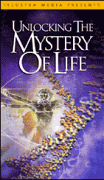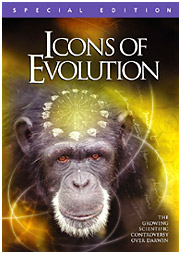|
|
|
|
EVOLUTION AND INTELLIGENT DESIGN Notes on three videos David Mays |
|
Opening Darwin’s Black Box – An Interview with Dr. Michael Behe, Princeton
Video Series, The C. S. Lewis Society, Trinity College of Florida, and The
Christian Network, 813-376-6911, 28 minutes In 1996, Darwin’s Black Box –
The Biochemical Challenge to Evolution, caused quite a stir in the
scientific world. It was reviewed by
more than 75 publications, drawing a very mixed response. A biochemist and molecular biologist at
Lehigh University, Behe was trained in evolutionary biology and never
questioned it until he read Evolution: A Theory in Crisis by Michael
Denton. The video shows how Behe
became a skeptic of Darwinsim. His
own research shows that the cell consists of many molecular machines
exhibiting “irreducible complexity,” that is, multiple components that must
all be present and operating for the machine to function. The challenge is to postulate how all the
components could have evolved simultaneously. In the video, graphic models of the functioning cell
demonstrate the concept of irreducible complexity. Icons of Evolution – The Growing Scientific Controversy Over Darwin, ColdWater
Media, LLC, Palmer Lake, CO
800-889-8670, 51 minutes www.coldwatermedia.com
According
to a growing number of scientists, students are not learning the whole truth
about Darwin’s theory of evolution.
The video claims that many of the most famous “icons of evolution” –
including Darwin’s “Tree of Life,” finches from the Galapagos Islands, and
embryos that look remarkably similar—are based on outdated research and weak
logic. Students are being hurt by the
failure to present both sides of an emerging scientific debate over Darwin’s
theory. (from the back cover). The
centerpiece of the video is the case of a high school teacher in Washington
State that received national news coverage because of the controversy over
his presenting evidence against evolution as well as for it. Whereas before the Scopes trial, the
nation as a whole disbelieved in evolutionary theory and wanted to ban
teaching evidence for it, the nation now believes evolutionary theory and
wants to ban teaching evidence against it! Unlocking the Mystery of Life – The Scientific Case for Intelligent
Design, Illustra
Media, 65 minutes, www.illustramedia.com This
was my favorite of the three. The
graphic models and natural photography are excellent. Narration is in brief clips by a number of
prominent scientists. The tone is
calm and reasoning. The logic is very
clear and convincing. There are no
attacks or bitter verbiage. There are
two issues to resolve with Darwinian evolution. What accounts for the many fundamentally different
species? And how did life originate
from non-living matter? In
1993 Phillip Johnson, author of Darwin on Trial,
convened a group of scientists and philosophers who had questioned the
Darwinian theory of evolution based on issues from their own
disciplines. They began to seek a new
approach to understanding the origin and diversity of life. Does the answer belong to chance plus
necessity or is it possible there is purpose, an intelligent cause? Before
Darwin, scientists commonly understood life as the result of a divine
plan. Darwin’s theory posed natural
selection as the substitute for divine guidance, the ‘creative agent’ that
eventually resulted in fundamentally different organisms. Thus time, chance,
and natural selection replaced the theories of creation. However,
a growing number of scholars are challenging key aspects of Darwinian
theory. This video is a summary of
those challenges presented clearly and compellingly. One
of the biggest challenges to the spontaneous generation of life is the source
of the information in the DNA. How
could amino acids spontaneously organize themselves into protein without the
set of instructions provided by the DNA?
DNA is the most densely packed and elaborately detailed and
efficiently utilized assembly of information in the known universe. What is the source of the information in
the DNA? The
concept of intelligent design matches the multiple discoveries of molecular
biology. Science ought to be a search
for truth about the world. It doesn’t
do to set aside a set of answers because you don’t like them. When we come to a puzzle we ought to bring
every possible cause that might explain the puzzle. Scientific naturalism artificially rules out some possible
solutions. Design is ruled out as a
scientific explanation. Yet we use
intelligent design as part of our scientific thinking all the time. “It
(intelligent design) might have religious implications but it doesn’t depend
on religious premises.” (Michael
Behe) In
the 19th century we recognized two fundamental entities, matter
and energy. Now we know there are
three: matter, energy and information.
DNA is an artifact of intelligence. The
narrators include Michael
Behe, biochemist from Lehigh University, Stephen C. Meyer, philosopher of
Science from The Discovery Institute, Paul Nelson, philosopher of biology and
author of On Common Descent, William Dembski,
mathematician from Baylor University, Jed Macosko, molecular biologist from
the University of California at Berkeley, Dean Kenyon, professor of biology
(emeritis) from San Francisco State University, Scott Minnich, molecular
biologist from the University of Utah, and Jonathon Wells, biologist and
author of Icons of Evolution. *** |
|||


